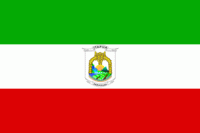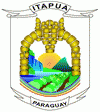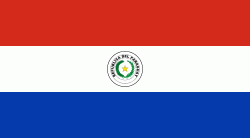Itapúa Department (Departamento de Itapúa)
 |
 |
This department was created after the breakup of the Misiones Department, with the city of Encarnación as the capital. It had high economic growth in the first 30 years of the arrival of immigrants and the Carlos Antonio Lopez Railway; the growth was accompanied by several ups and downs.
An era of decline followed until the 1950s when the Carnaval Encarnaceno became better known and attracted tourists from various regions. In the 1980s the department became more industrial, but modestly so compared with other departments like the Central Department.
In 1989 the Yacyretá Dam displaced the people living in the Yacyretá Reservoir; the displacement still continues. The San Roque González de Santa Cruz Bridge was inaugurated in 1991, connecting not only the city of Encarnación and Posadas, but also Paraguay with Argentina.
Map - Itapúa Department (Departamento de Itapúa)
Map
Country - Paraguay
 |
 |
| Flag of Paraguay | |
Spanish conquistadores arrived in 1524, and in 1537 established the city of Asunción, the first capital of the Governorate of the Río de la Plata. During the 17th century, Paraguay was the center of Jesuit missions, where the native Guaraní people were converted to Christianity and introduced to European culture. After the expulsion of the Jesuits from Spanish territories in 1767, Paraguay increasingly became a peripheral colony, with few urban centers and settlers. Following independence from Spain in the early 19th century, Paraguay was ruled by a series of authoritarian governments characterized by nationalist, isolationist and protectionist policies. This period ended with the disastrous Paraguayan War (1864–70), during which the country lost half its prewar population and around 25–33% of its territory to the Triple Alliance of Argentina, Brazil and Uruguay. In the 20th century, Paraguay faced another major international conflict—the Chaco War (1932–35) against Bolivia—in which it prevailed. Afterwards, the country came under a succession of military dictators, culminating in the 35-year regime of Alfredo Stroessner, which lasted until his overthrow in 1989 by an internal military coup. This marked the beginning of Paraguay's democratic era, which continues to this day.
Currency / Language
| ISO | Currency | Symbol | Significant figures |
|---|---|---|---|
| PYG | Paraguayan guaranà | ₲ | 0 |
| ISO | Language |
|---|---|
| GN | Guarani language |
| ES | Spanish language |















